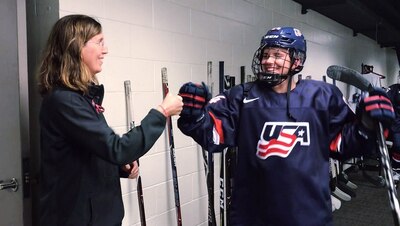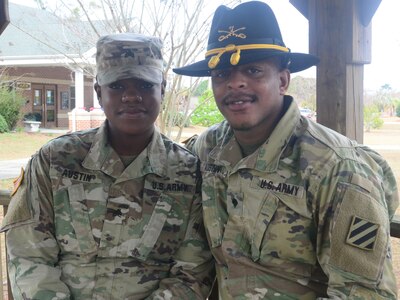By Lori Newman Brooke Army Medical Center
JOINT BASE SAN ANTONIO-FORT SAM HOUSTON, Texas, Feb. 26,
2018 —Under the watchful eye of his physical therapist, a patient slowly worked
a weighted towel across the floor by turning his left ankle. This was just one
of several exercises he performed during his rehabilitation appointment at the
Center for the Intrepid at Brooke Army Medical Center here.
“This actually feels pretty good,” David Colbath said as he
worked diligently to strengthen his ankle.
Seeing him now, it’s hard to believe Colbath was shot eight
times a little over three months ago on a peaceful Sunday morning in a small
country church in Sutherland Springs, Texas. That day, a lone gunman took the
lives of 26 people and forever changed the lives of 20 others who were wounded
by the gunfire.
Colbath is one of eight people who were brought to Brooke
Army Medical Center with multiple gunshot wounds Nov. 5, 2017. The 56-year-old
was shot in the right arm, calf, ankle and several times in his backside. “God
didn’t do this,” he said. “Evil came into our church, and evil through the
devil did this.”
Before coming to BAMC, Colbath had never been in a hospital.
After spending three and a half weeks in the hospital and undergoing five
surgeries to repair his wounds, he said, he is grateful to be alive.
BAMC surgeons repaired Colbath’s right arm using a vein from
his leg to reconstruct one of two blood vessels in his forearm to restore blood
flow to his hand. Following the reconstruction by the vascular team, an
orthopedic surgical team performed nerve reconstruction in the same area and
rotated muscle over the vascular and nerve reconstruction to prevent infection
and allow his arm to heal.
“I think our trauma team and all the trauma support services
performed exceptionally well,” said Air Force Lt. Col. (Dr.) Brandon Propper,
vascular surgeon and program director for general surgery. “We were able to get
into the operating room very quickly and re-establish vascular flow in a timely
fashion to give him the best chance of limb salvage.”
Thankful for Treatment
Colbath is thankful for the treatment he has received at
BAMC. “I think BAMC is the greatest trauma center in the world,” he said.
BAMC is the Defense Department’s only Level 1 trauma center
and is one of two Level 1 trauma centers in San Antonio. Alongside University
Health System, BAMC administers lifesaving care to more than 4,000 trauma patients
each year, from an area that stretches across 22 counties in Southwest Texas
and encompasses 2.2 million people. Of the over 4,000 trauma patients admitted
each year, 85 percent are community members without military affiliation.
“Within the first week I was at BAMC, I started to realize
the true sweetness of every doctor, every nurse, every practitioner, whoever
they were -- they were truly good people coming to help me,” Colbath said. “I
can’t remember all of their names, but they were truly sweet, good people.”
Colbath’s injuries are slowly healing, but he still
experiences pain from the physical wounds inflicted that day. “I want to focus
on my recovery now; what happened in the church is in the past,” he said.
As part of his recovery, Colbath is working with physical
and occupational therapists at the Center for the Intrepid two to five days a
week to regain movement and strength in his arm, hands and ankles. The CFI team
is using a combination of therapeutic exercises including high-intensity
interval training, strengthening, cardio and balance to help Colbath return to
his previous level of functioning.
“I’m a driven man, and the staff here are driven people,”
Colbath said.
“We have a wonderful clinical team here at the CFI,” agreed
physical therapist Oluwasegun Olomojobi. “We all work together in making sure
he is able to reach his functional goals.”
Colbath said he already has noticed a tremendous increase in
the use of his hands in the short time said he has worked the CFI staff. “Three
weeks ago, I couldn’t get down on the ground and get back up without crawling
to something to get up,” he added. ”Now I can get down and back up on my own,
and I’m happy about that.”
Impressive Progress
Olomojobi said he’s been impressed with Colbath’s progress.
“He has improved tremendously since his first day here at the CFI,” he said.
“He is fully integrated into all that the CFI offers and gives a 110 percent
effort every visit. We’ve seen improvements in virtually all areas of his rehab
care.”
As part of his rehab, Colbath, an avid hunter, is working
with Scott Fitzgerald, the firearms training simulator instructor, to learn how
to shoot left-handed. Fitzgerald is helping Colbath with his hand/eye
coordination and physical stance as he gets used to using his left hand to
squeeze the trigger. He also showed Colbath different ways of loading and
chambering the gun, as well as new techniques for sighting the target. “I’ve
been hunting since I was 6 years old,” Colbath said. “But this is all new to
me.”
“We are taking the muscle memory he already has and changing
it from a right-hand dominancy to a left-hand dominancy,” Fitzgerald explained.
“It’s going to take time for that to feel more normal, but he moves very well
doing it.”
Fitzgerald said he has noticed a marked improvement since
Colbath began using his left hand as his dominant hand when shooting.
“A loud noise still scares me,” Colbath admitted, explaining
that a few weeks earlier, he was at a party and a balloon popped. “I nearly had
a cow, it scared me so much,” he said. “So, I’m not ready to shoot a live gun
yet. But I want to prepare myself for it, though.”
Colbath said he’s fully committed to his recovery.
“I don’t want to leave anything on the table,” he said. “I
want to be as well as God will let me. I want to say that I went to the [Center
for the Intrepid] and we did everything possible. … I want to know that I made
every effort to be as well as I can be.”









